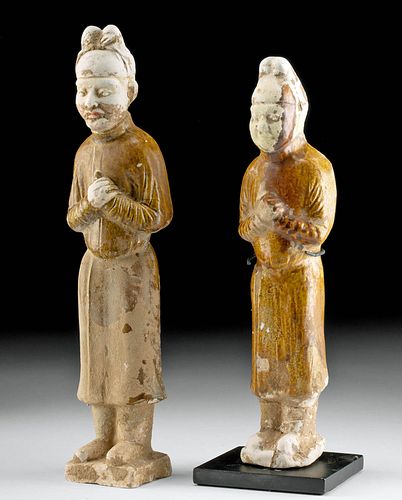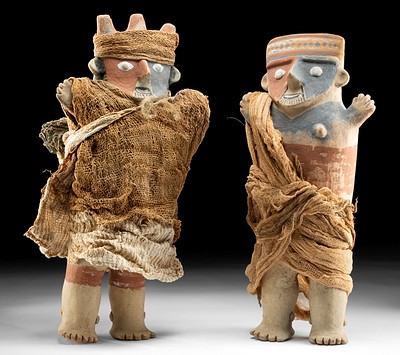2 Chinese Tang Sancai Pottery Attendant Figures, TL'd
Lot 80c
About Seller
Artemis Fine Arts
686 S Taylor Ave, Ste 106
Louisville, CO 80027
United States
Selling antiquities, ancient and ethnographic art online since 1993, Artemis Gallery specializes in Classical Antiquities (Egyptian, Greek, Roman, Near Eastern), Asian, Pre-Columbian, African / Tribal / Oceanographic art. Our extensive inventory includes pottery, stone, metal, wood, glass and textil...Read more
Categories
Estimate:
$2,200 - $3,300
Absentee vs Live bid
Two ways to bid:
- Leave a max absentee bid and the platform will bid on your behalf up to your maximum bid during the live auction.
- Bid live during the auction and your bids will be submitted real-time to the auctioneer.
Bid Increments
| Price | Bid Increment |
|---|---|
| $0 | $25 |
| $300 | $50 |
| $1,000 | $100 |
| $2,000 | $250 |
| $5,000 | $500 |
| $10,000 | $1,000 |
| $20,000 | $2,500 |
| $50,000 | $5,000 |
| $100,000 | $10,000 |
| $200,000 | $20,000 |
About Auction
By Artemis Fine Arts
May 19, 2022
Set Reminder
2022-05-19 10:00:00
2022-05-19 10:00:00
America/New_York
Bidsquare
Bidsquare : Fine Antiquities | Ethnographica | Fine Art
https://www.bidsquare.com/auctions/artemis-gallery/fine-antiquities-ethnographica-fine-art-9350
Featuring a very special collection of Fine Art from the Hollywood Hills, including Picasso & Rookwood ceramics! Also included are many fine examples of classical antiquities, ancient, and ethnographic art from cultures encompassing the globe. Artemis Fine Arts info@artemisgallery.com
Featuring a very special collection of Fine Art from the Hollywood Hills, including Picasso & Rookwood ceramics! Also included are many fine examples of classical antiquities, ancient, and ethnographic art from cultures encompassing the globe. Artemis Fine Arts info@artemisgallery.com
- Lot Description
East Asia, China, Tang Dynasty, ca. 618 to 906 CE. A fine pair of mold-formed pottery tomb attendants standing atop integral rectangular plinths. Each figure presents wearing a shin-length robe covered in faded sancai glaze in orange and yellow hues and clasps their arms in a respectful gesture in front of their chest. Their haunting faces stare forward with beady eyes protruding from beneath gentle lids, and remains of red pigment on the lips of one figure indicate how lifelike these figures would have appeared when first created. The shorter figure is shown wearing a simple cap with a single tab brim rising along the verso, and the taller figure dons a domed cap with a twin-lobed top element. Size (taller figure): 2.6" W x 10.625" H (6.6 cm x 27 cm); (shorter figure): 2.3" W x 9.5" H (5.8 cm x 24.1 cm); 9.875" H (25.1 cm) on included custom stand.
Though these figures only display 2 primary glaze colors - orange and yellow - they would have originally had green glaze hues across their bodies as well. The term "sancai" means "three colors" and is a type of decoration in Chinese pottery using intermingled colors for decoration; it is a signature of the Tang Dynasty. Pieces like these would have been made by using white clay to form the overall shapes, firing them to preserve the forms, then applying glaze. Three major kilns in northern China were responsible for making these pieces, which were designed to go into the tombs of Tang aristocracy.
The Tang Dynasty was a thrilling time in Chinese history, when trade flourished along the Silk Routes and unified China was the richest country on earth. Chang'an (now Xi'an) was the Tang capital, and it was one of the most cosmopolitan cities on earth, filled with foreigners who had travelled to China to trade; the influence of foreigners and talented native Chinese, combined with the economic prosperity brought on by trade and the new religion from India, Buddhism, created a powerful cultural milieu where poetry and other forms of art flourished.
These pieces have been tested using thermoluminescence (TL) analysis and have been found to be ancient and of the period stated.
Provenance: private San Francisco, California, USA collection, acquired 1970s to 2000s
All items legal to buy/sell under U.S. Statute covering cultural patrimony Code 2600, CHAPTER 14, and are guaranteed to be as described or your money back.
A Certificate of Authenticity will accompany all winning bids.
PLEASE NOTE: Due to recent increases of shipments being seized by Australian & German customs (even for items with pre-UNESCO provenance), we will no longer ship most antiquities and ancient Chinese art to Australia & Germany. For categories of items that are acceptable to ship to Australia or Germany, please contact us directly or work with your local customs brokerage firm.
Display stands not described as included/custom in the item description are for photography purposes only and will not be included with the item upon shipping.
#170545Repairs to plinths, feet, and ankles of both figures, with light adhesive residue and applied earthen material along break lines. Both pieces have fading and chipping to original glaze pigment, softening to some finer details, a few small spalls, and encrustations across surfaces. Great remains of original glaze throughout. Both figures have 1 TL drill hole beneath base and 1 TL drill hole on back or side of neck. Shorter figure on display stand cannot stand upright unassisted, however taller figure is able to stand unassisted.Condition
- Shipping Info
-
All shipping is handled in-house for your convenience. Your invoice from Artemis Gallery will include shipping calculation instructions. If in doubt, please inquire BEFORE bidding for estimated shipping costs for individual items.
-
- Buyer's Premium



 EUR
EUR CAD
CAD AUD
AUD GBP
GBP MXN
MXN HKD
HKD CNY
CNY MYR
MYR SEK
SEK SGD
SGD CHF
CHF THB
THB














